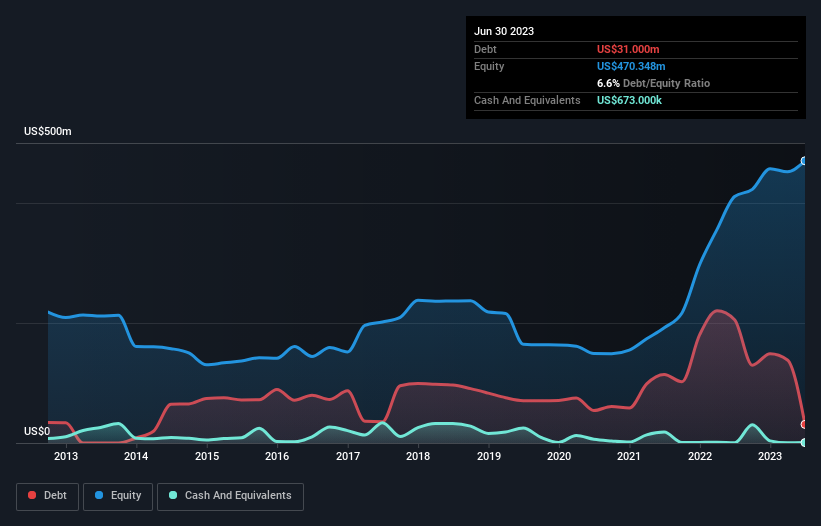- United States
- /
- Healthcare Services
- /
- NasdaqGS:CCRN
These 4 Measures Indicate That Cross Country Healthcare (NASDAQ:CCRN) Is Using Debt Reasonably Well

Warren Buffett famously said, 'Volatility is far from synonymous with risk.' So it might be obvious that you need to consider debt, when you think about how risky any given stock is, because too much debt can sink a company. We can see that Cross Country Healthcare, Inc. (NASDAQ:CCRN) does use debt in its business. But is this debt a concern to shareholders?
Why Does Debt Bring Risk?
Debt assists a business until the business has trouble paying it off, either with new capital or with free cash flow. In the worst case scenario, a company can go bankrupt if it cannot pay its creditors. However, a more common (but still painful) scenario is that it has to raise new equity capital at a low price, thus permanently diluting shareholders. Of course, debt can be an important tool in businesses, particularly capital heavy businesses. The first step when considering a company's debt levels is to consider its cash and debt together.
Check out our latest analysis for Cross Country Healthcare
How Much Debt Does Cross Country Healthcare Carry?
The image below, which you can click on for greater detail, shows that Cross Country Healthcare had debt of US$31.0m at the end of June 2023, a reduction from US$205.4m over a year. However, it does have US$673.0k in cash offsetting this, leading to net debt of about US$30.3m.

A Look At Cross Country Healthcare's Liabilities
Zooming in on the latest balance sheet data, we can see that Cross Country Healthcare had liabilities of US$216.0m due within 12 months and liabilities of US$84.8m due beyond that. Offsetting these obligations, it had cash of US$673.0k as well as receivables valued at US$496.8m due within 12 months. So it actually has US$196.7m more liquid assets than total liabilities.
This surplus suggests that Cross Country Healthcare is using debt in a way that is appears to be both safe and conservative. Given it has easily adequate short term liquidity, we don't think it will have any issues with its lenders.
We measure a company's debt load relative to its earnings power by looking at its net debt divided by its earnings before interest, tax, depreciation, and amortization (EBITDA) and by calculating how easily its earnings before interest and tax (EBIT) cover its interest expense (interest cover). The advantage of this approach is that we take into account both the absolute quantum of debt (with net debt to EBITDA) and the actual interest expenses associated with that debt (with its interest cover ratio).
Cross Country Healthcare has a low net debt to EBITDA ratio of only 0.15. And its EBIT covers its interest expense a whopping 13.9 times over. So we're pretty relaxed about its super-conservative use of debt. It is just as well that Cross Country Healthcare's load is not too heavy, because its EBIT was down 30% over the last year. When it comes to paying off debt, falling earnings are no more useful than sugary sodas are for your health. The balance sheet is clearly the area to focus on when you are analysing debt. But ultimately the future profitability of the business will decide if Cross Country Healthcare can strengthen its balance sheet over time. So if you're focused on the future you can check out this free report showing analyst profit forecasts.
Finally, a business needs free cash flow to pay off debt; accounting profits just don't cut it. So we clearly need to look at whether that EBIT is leading to corresponding free cash flow. Looking at the most recent three years, Cross Country Healthcare recorded free cash flow of 35% of its EBIT, which is weaker than we'd expect. That's not great, when it comes to paying down debt.
Our View
Cross Country Healthcare's interest cover suggests it can handle its debt as easily as Cristiano Ronaldo could score a goal against an under 14's goalkeeper. But we must concede we find its EBIT growth rate has the opposite effect. It's also worth noting that Cross Country Healthcare is in the Healthcare industry, which is often considered to be quite defensive. Looking at all the aforementioned factors together, it strikes us that Cross Country Healthcare can handle its debt fairly comfortably. Of course, while this leverage can enhance returns on equity, it does bring more risk, so it's worth keeping an eye on this one. When analysing debt levels, the balance sheet is the obvious place to start. However, not all investment risk resides within the balance sheet - far from it. These risks can be hard to spot. Every company has them, and we've spotted 2 warning signs for Cross Country Healthcare (of which 1 is concerning!) you should know about.
Of course, if you're the type of investor who prefers buying stocks without the burden of debt, then don't hesitate to discover our exclusive list of net cash growth stocks, today.
New: AI Stock Screener & Alerts
Our new AI Stock Screener scans the market every day to uncover opportunities.
• Dividend Powerhouses (3%+ Yield)
• Undervalued Small Caps with Insider Buying
• High growth Tech and AI Companies
Or build your own from over 50 metrics.
Have feedback on this article? Concerned about the content? Get in touch with us directly. Alternatively, email editorial-team (at) simplywallst.com.
This article by Simply Wall St is general in nature. We provide commentary based on historical data and analyst forecasts only using an unbiased methodology and our articles are not intended to be financial advice. It does not constitute a recommendation to buy or sell any stock, and does not take account of your objectives, or your financial situation. We aim to bring you long-term focused analysis driven by fundamental data. Note that our analysis may not factor in the latest price-sensitive company announcements or qualitative material. Simply Wall St has no position in any stocks mentioned.
About NasdaqGS:CCRN
Cross Country Healthcare
Provides talent management services for healthcare clients in the United States.
Flawless balance sheet and good value.
Similar Companies
Market Insights
Community Narratives



